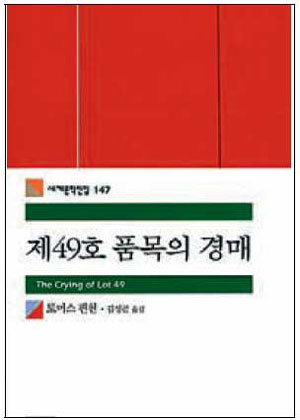[Book] Communication of Information Revealed by Physics Theory
[Book] Communication of Information Revealed by Physics Theory
Posted March. 11, 2008 03:05,

Thomas Pynchon, who has been frequently nominated as a contender for the Nobel Prize in Literature almost every year, is a well-known leading postmodernist author. His novels are regarded by many readers and critics as one of the most difficult ones to read since they are filled with complicated symbols and signs.
His third fiction Gravitys Rainbow was recommended for the Pulitzer Prize in 1974. However, the Pulitzer board vetoed the jurys recommendation, citing the novel as "unreadable." There was no prize winner that year.
The Crying of Lot 49 is his second novel published in 1966. As the shortest of Pynchon`s novels, it has been considered relatively accessible compared to his other works.
This book begins with a scene in which an ordinary housewife Oedipa, living in the U.S., receives a letter saying her old boy friend Pierce died and that she was made co-executor of his estate. After going to San Narciso in southern California to execute Pierces property, Oedipa happens to track down an underground mail distribution system called the Tristero, which manufactures and exchanges fabricated stamps.
She later realizes that the Tristero is an underground organization used by less privileged people in society under the name of W.A.S.T.E. She also learns that their slogan W.A.S.T.E. is an acronym for We Await Silent Tristero`s Empire.
Pynchon, who studied physics but later changed his major to English, employs a physics theory called entropy in this novel. He uses it as a metaphor for the communication of information.
The author tries to convey a message, saying a system that has no exchanges and is not open to the outside is bound to be doomed. Therefore it must be transformed to an open one. The mail system in the novel represents the control of the human exchanges and communications.
Oedipa becomes skeptical about her knowledge about the truth and reality while she is searching for the Tristero and harbors suspicion that another world may exist beyond her world.
In the novels final section, Oedipa hears that a fake set of postage stamps is put up at auction under the title of "Lot 49." She attends the auction, believing that representatives of the Tristero are trying to acquire the set in order to keep their secret.
The book ends with Oedipas waiting for the bid. The author leaves the endings of his most celebrated novels open-ended, an outright characteristic of postmodernist literature.
Readers meet with numerous parodies and symbols toward the American pop culture while reading this novel. There are quite a few parts that would challenge readers in catching their symbolic messages if there were no translation notes by the editor. In the novel, Pynchon intentionally mixes fictions with facts or distorts history. Through these methods, he raises a fundamental question about reliability of all original texts including official history.
If readers are not familiar with his works, beginning the book from a commentary of the editor at the end of the book is a good idea. Kim Seong-gon, professor of English Literature at Seoul National University, who received a Ph.D with his study on Pynchon, translated the book. His articulate explanations and commentaries on the detailed signs and symbols throughout the book would enrich the pleasure of reading this finest novel.
sjkang@donga.com







